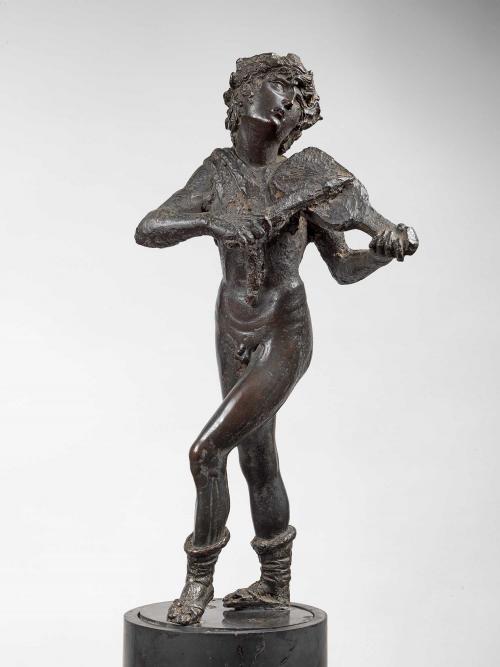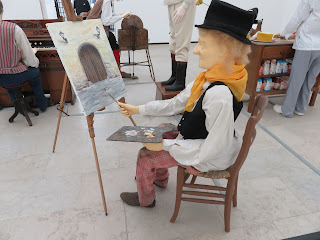In January I made a trip to New York, just to see the
Bertoldo di Giovanni exhibition at the Frick Collection. I had no idea that New
York would be closing down in a couple of months. My Ph.D. is in Italian
Renaissance Sculpture, this was the first time the entire body of Bertoldo’s
work has been shown in one place, and I was a graduate school colleague of Jim
Draper, the Bertoldo expert to whom the catalogue is dedicated. It seemed
important to go.
The Frick Collection has two small special exhibition galleries
in the lower level, separated by a small vestibule where the exhibition
catalogue is on display, usually with one work. I like this arrangement, mainly
because it limits the number of objects on view and makes it easy to focus on
the individual works of art without worrying about getting through an enormous
display. I find it liberating that the exhibitions are relatively small and
focused. Because exhibitions at the Frick are more scholarly than most, there
are usually few visitors, again encouraging careful study of the works of art.
The Frick doesn’t permit photographs, but at an earlier visit
the guard helpfully told me that the images are all available online, and that
proves
true for Bertoldo also. It is lovely that the Frick provides photographs and information on the works at its exhibition website, so you can see everything in the exhibition online. At the same time, it is particularly characteristic of sculpture exhibitions that reproductions cannot capture the spatial aspects of the works, the depth of relief, the details that can be seen from different viewing angles, and the way the art object actually occupies space. I love this about sculpture and I believe some painting experts find it challenging.
The exhibition included nineteen of the twenty works
the curators think can be attributed to Bertoldo. One series of reliefs was noted
only in the catalogue, since it is attached to a building, the Palazzo Scala
della Gherardesca in Florence. And one series of reliefs, in the exhibition, was
executed by at
least five different artists, presumably after designs by Bertoldo. Bertoldo worked in Donatello’s studio had a role in training Michelangelo. Art historians see many connections among the three artists; part of the role of the exhibition was to call attention to Bertoldo as an artist in his own right, rather than just a conduit between two Renaissance geniuses. I much appreciated that. The exhibition catalogue is full of fascinating information and richly illustrated. Bertoldo was close to Lorenzo de’ Medici and even lived for a time in the Medici Palace.
 |
| Battle between Romans and barbarians, marble, late second century CE, Camposanto, Pisa. |
 |
| Bertoldo di Giovanni, Battle, bronze, ca. 1480-85, Museo Nazaionale del Bargello, Florence |
The first work one saw, in that introductory vestibule, was
Battle, ca. 1480-85, a bronze relief roughly 18 by 40 inches. Bertoldo copied
it from a much larger marble Roman sarcophagus that he would have seen in the
Benedictine abbey of San Zeno in Pisa. The sarcophagus was damaged, with most
of the heads and the center portion gone, so he had the opportunity to revise
it, at the same time he acknowledged his classical source. The label included a
photograph of the sarcophagus and I was struck by how similar the compositions
were; he definitely was copying the antiquity at the same time he was improvising
on the theme of battle. Scholars have attempted to identify a specific battle,
either mythological or contemporary, but they do not agree on the subject. Seeing the work in person makes the high
relief more striking; multiple heads and arms are in complete three dimensions.
The faces, clothing, hair, and musculature of the men and horses are in crisp
detail, the result of careful carving and polishing that were necessary to
complete Renaissance bronzes after they are cast.
The interaction, intertwining of the active men and horses
provides much to investigate. The relief is flanked by three female and one male
standing figures, with two bound and captive nude males at their feet. The
standing figures are copied, but modified, from the Roman original.
In the catalogue entry, Alexander J. Noelle points out that
Bertoldo probably visited Pisa relatively often and acknowledges Wilhelm von Bode’s
thought that Bertoldo would have accompanied Lorenzo de’ Medici on his frequent
visits to Pisa, where Lorenzo had a home. Lorenzo was the de facto ruler of Florence,
although he did not have any official position. Bertoldo had the unusual opportunity
to be a friend of Lorenzo and at some times even to live in his palace. So, we
might imagine Lorenzo and Bertoldo discussing the relief and Lorenzo asking
Bertoldo to make him a version of the battle for his fireplace in the Palazzo
Medici. The plan might have been simply to depict a battle, with no specific
one in mind, providing his patron, Lorenzo de’ Medici, with a gorgeous classical
subject for his palazzo.
How would he have made this copy? I imagine that he made detailed
drawings and perhaps even modelled a copy of the relief in clay in Pisa and
transported them to Florence, where he would have made the final wax model and
had the bronze cast in a foundry there. Julia Day, in the exhibition catalogue,
suggests that since Bertoldo lived in the Medici Palace, he may not have had
space for his own foundry and used that of another artist and bronze caster, probably
Adriano Fiorentino.
 |
| Bertoldo di Giovanni, Orpheus , ca 1471, bronze, Museo Nazionale del Barbello, Florence |
One of my favorite works in the exhibition is the small bronze
titled Orpheus, but which has also been thought to represent Apollo.
With his twisting body suggestive of dancing, his upturned head that seems in a
bit of a trance, and his roughly formed lira da braccia (a common
Renaissance stringed instrument), he evokes a spirit of music. The sculpture
shows especially effectively how much work an artist does after a bronze is
cast, chiseling, filing, and polishing the surface, since parts of it -half the
face, the hair, the instrument, part of the torso and animal skin on his
shoulders – are still rough-cast. The unfinished quality interestingly
romanticizes the image. The catalogue reports a 1471 document published in 2005
that says Bertoldo gave a bronze of Orpheus to a woolen merchant to pay his
bill. It is fascinating that the cast itself is seriously flawed, with a huge
crack up the back, and to think Bertoldo gave up on it because of the flaw. In
addition, he used it to pay a debt in 1471 and may have passed it to the woolen
merchant without finishing it.
 |
| Bertoldo di Giovanni, Bellerophon Taming Pegasus, ca. 1480-82, bronze, Kunstkammer, Kunsthistorisches Museum, Vienna |
Another documented work by Bertoldo is Belleraphon Taming
Pegasus, which has the fascinating signature “Bertoldo modeled me, Adriano [Fiorentino]
cast me,” documenting the association between Bertoldo the sculptor and Adriano
the founder. Presumably Bertoldo did the final chasing after Adriano cast the
figures in bronze. It captures the active nude Belleraphon taking control of
the winged horse, Pegasus, with highly polished and carefully detailed
surfaces.
 |
| Donatello?, Bertoldo di Giovanni?, St. Jerome, ca 1465-66, wood, gesso, paint, Pinacoteca Comunale, Faenza |
A wood sculpture of St. Jerome, covered in gesso and
paint, seems to be the most controversial object in the exhibition, attributed
to Donatello and/or Bertoldo. I gather that scholars continue to debate who
made the figure, but my own response was to be repulsed by the odd color of the
skin. I wondered how much it has been restored and what it might have looked
like before it was repainted. The
catalogue discusses what the conservators discovered during the restoration, and
its photographs indicate that the surface was probably pretty completely remade
so the work looks almost new.
 |
| Bertoldo di Giovanni and Followers, Frieze for the Portico of Vill Medici at Poggio a Caiano, ca 1490, glazed terracotta, Villa Medicea di Poggio a Caiano, Polo Museale della Toscana |
The exhibition contains mostly bronzes, but I was surprised
to see a terracotta frieze, from front of the Medici villa at Poggio a Caiano,
arranged around the walls of the second gallery. While the unidentified subject
is definitely classical, it’s obvious that several artists – the catalogue says
five – executed it and there is no documentation that Bertoldo was associated
with it. The attribution comes from the fact that he died at Poggio a Caiano
and thus might have been there to design the frieze, which possibly he and
others executed. The reliefs are varied in quality, with different depths of relief,
different spacing of figures, and more and less clumsy modelling. But since it
was intended for an upper cornice on the outside of a building, having the
figures silhouetted against a blue background with some of the eyes exaggeratedly
deep, might have been all that was necessary. It did make we want to go to
Poggio a Caiano.
The exhibition also included six medals designed by
Bertoldo. Nicely displayed, so both sides can be seen, they are historically
interesting. Having some experience with medals, I find them very difficult to
appreciate, however, without being able to hold them, since they were intended
to be handled.
This was one of a series of exhibitions examining the work
of Renaissance artists who worked in bronze. The Frick has a large collection
of small bronzes and it’s impressive that they are using the collection as a
springboard for fascinating exhibitions with substantial scholarly catalogues.


















































